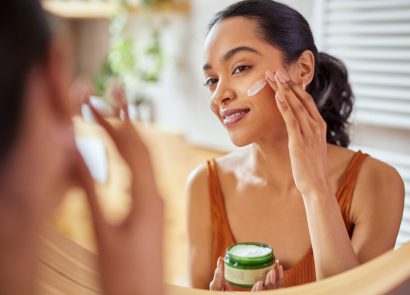1. Youtube the ‘modified bass technique’
We all know how to brush our teeth, right? Well, maybe not. Those leggy, root-exposed teeth that really age a smile can all be down to technique. “When it’s done badly, brushing can make the gums recede,” points out Dr Richard Marques, who has worked on the smiles of chart diva Rita Ora, and Olympic diver Tom Daley (wimpolestreetdental.com). “Once that happens, you can’t bring it back except with gum grafting, which is quite a severe procedure. The worst thing, is where patients have a hard toothbrush and really scrub the tooth. We’ve all done it, but what dentists recommend, is a motion called the ’modified bass technique’ where you use round motions angling your brush towards your gum.”
2. Graze smarter…
Dried fruit, smoothies and fresh fruit all contribute to our five (or 10!) a day, but the little-and-often approach to getting them in could be prematurely deteriorating your teeth. “As a profession, we’re seeing more damage and decay because people are choosing healthier lifestyles,” says dental surgeon Matthew Rose of The Implant Centre (theimplantcentre.com). Like many dentists, he’s dealing with the side effects of fruit-based snacks and drinks. “It’s all about how often you have them in the daytime,” says Matthew. “Basically, every time you ingest something containing sugar, your teeth will be decaying for about 20 minutes afterwards. If you’re doing that regularly in the day that’s quite a long time that your teeth are being attacked, rather than having the chance to recover and naturally remineralise.” Switching to nuts or raw veg will help reduce the damage done by snacking.
3. …And don’t be too brush-happy
Ever had that nasty toothpaste-after-orangejuice taste? You could have upset more than your taste buds. “You can’t brush your teeth immediately after having fruit snacks and juices,” says Matthew. “They’re acidic, so on a microscopic level they leave the surface of your tooth soft and vulnerable to wear from brushing.
It’s best to wait for an hour or so.” Following acidic juices or smoothies with a drink of water may limit the damage to your teeth.
4. Stop grinding!
“Grinding can cause the loss of the height of the tooth, so they get shorter, and more translucent,” says Richard. “That’s one of the effects we associate with ageing. Studies have found that bigger teeth look more youthful while smaller, thinner and yellowing teeth, look older.” The solution? Hypnotherapy and even botox can help relax jaw muscles, but the first step is to ask your dentist to make you a bite guard. “Teeth lay down more of the yellow dentine during grinding,” adds Matthew, “so it’s important to catch it early. A bite guard may not stop the grinding habit completely, but it’ll certainly prevent further damage.”
5. Drink water
Saliva plays an important part in the remineralisation of teeth, so staying hydrated is an essential part of keeping your teeth from prematurely deteriorating. Drinking water after juices or smoothies may also help prevent or dilute corrosive acids from sitting on the teeth. But swishing, swilling or sipping water after brushing your teeth can wash away some of the fluoride deposited during brushing. It’s best to get your eight glasses in before you reach for the brush.
6. Check your toothpaste’s label
It’s not uncommon to encounter fluoride-free toothpastes, especially in holistic health shops, but for Matthew, the mineral is an essential ally against wear and tear on teeth. “Tooth decay is an issue of demineralisation over time, and anything acidic will cause demineralisation. It’s the sugar converted into acid in the tooth that causes decay. Fluoride is very effective at remineralising teeth – toothpaste is essentially a vehicle for delivering topical fluoride to the tooth’s surface. If a toothpaste hasn’t got it, it’s not really bringing benefits. Frequent application has been shown to reduce tooth decay and remineralise teeth.”
7. Swerve whitening kits
According to a recent report in The British Dental Journal, shoppers snapping up tooth whitening kits from trusted retailers such as Boots and Superdrug are putting their teeth at risk. So, is it worth taking steps to reverse the effects of time on your teeth’s shade? “Whitening, done professionally, will work,” says Dr Richard. “The only danger is having it done by unlicensed beauty therapists, who can use solutions made with acid that strip the enamel. Some save on costs by using bleaches that aren’t medical grade – even household bleach – or untested, unregulated products from Amazon. Your dentist will be using gels tested in clinical trials and covered by indemnity insurance. Just remember that it’s a medical procedure, not a beauty procedure.”
8. Reach for a straw
“Fruit juices and smoothies can be good for your overall health, but the acid they contain will wear the enamel, which makes it thinner and more translucent,” says Dr Richard. The effects will be both structural and visual, with the darker yellow dentine that forms the bulk of your tooth showing through the white enamel. “Rather than telling patients to stop drinking juices altogether, we recommend using a straw, which allows the acids to bypass the teeth.” Keeping a reusable bamboo or stainless steel straw in your handbag is the perfect way to protect your teeth, while appearing every bit the eco warrior. Win-win!
9. Fasting? chew gum
“It’s said that there’s a reduced amount of saliva during fasting, so plaque can build up leading to gum disease and decay,” says Richard. “You could chew sugar-free gum, which would stimulate saliva, but make sure to avoid gum formulated with sugar, because that’ll just contribute to decay.”
10. Clean cleverly
If you lack the stamina or determination to give your teeth the care they require, there are a few neat shortcuts. “The best method is with an electric toothbrush, especially the vibrating or sonic brushes,” says Richard. “They don’t scrub the tooth but they do the work for you.” You can also try a remineralising mouthwash before bed. “It should strengthen the enamel you have in place as the active ingredients – primarily fluoride – sit on the teeth overnight.”
Anti-ageing smile fixes
In an instant…
Choosing a lipstick with cool undertones – blue or purple – can create the optical effect of whiter teeth. A slick of Apa Blue Lip Shine (£20, net-a-porter.com) will give bare lips a tooth-whitening sheen.
In 30 minutes…
A scale and polish at the dentist isn’t anyone’s favourite activity, but the results can be surprising as plaque deposits and cumulative staining are scraped away. This treatment (if considered clinically necessary) falls into the NHS’s cheapest band of fees, so expect to pay around £21.60.
In 45 minutes…
Most teeth whitening treatments take at least two to three weeks to show results, but there are speedier options if you’re willing to spend more. Zoom! WhiteSpeed starts at £400 and promises results of up to six shades brighter. Visit philips.co.uk to find your nearest practitioner.
It’s all white
Teeth whitening can be a confusing subject, so we put our questions to Jordan Kirk, in-house expert at White Glo (whiteglo.com).
Q: Are whitening toothpastes safe?
A: Yes, teeth whitening toothpastes are safe to use, as long as you are following the manufacturer’s instructions and guidelines.
Q: Can they remove caffeine stains from my teeth?
A: Extrinsic stains refer to staining of the enamel, the hard surface protecting the more nervous dentin and pulp. Enamel comes into contact with everything you eat or drink, and over time it can absorb the pigments left over by these foods and beverages. Red pasta sauce, curry and berries can have this effect on your teeth, as can common drinks such as soda, coffee, tea and red wine. Tobacco, whether it’s smoked or chewed, is another possible cause of this type of staining. Because these stains are on the outer layer of your teeth – unlike intrinsic – you can usually remove them with whitening toothpastes. These work by gently brushing the surface of your enamel, which allows them to lift stains gradually as you scrub them. If whitening toothpaste isn’t enough, however, see your dentist – professional dental cleanings tackle surface stains, most of which can be removed in this way. To prevent your extrinsic stains from recurring right away, make sure you avoid consuming stain-causing products for several days after whitening your teeth.
Q: How long do whitening toothpastes take to work?
A: When using a whitening toothpaste twice a day, you can expect to see results within six weeks. These products are developed to give you a gradual result and, if using in conjunction with a teeth whitening kit, you can expect results quicker.




















